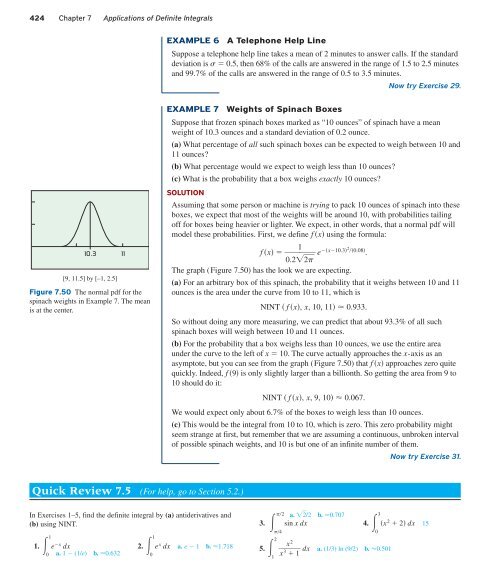You also want an ePaper? Increase the reach of your titles
YUMPU automatically turns print PDFs into web optimized ePapers that Google loves.
424 Chapter 7 Applications of Definite Integrals<br />
EXAMPLE 6<br />
A Telephone Help Line<br />
Suppose a telephone help line takes a mean of 2 minutes to answer calls. If the standard<br />
deviation is s 0.5, then 68% of the calls are answered in the range of 1.5 to 2.5 minutes<br />
and 99.7% of the calls are answered in the range of 0.5 to 3.5 minutes.<br />
Now try Exercise 29.<br />
10.3 11<br />
[9, 11.5] by [–1, 2.5]<br />
Figure 7.50 The normal pdf for the<br />
spinach weights in Example 7. The mean<br />
is at the center.<br />
EXAMPLE 7<br />
Weights of Spinach Boxes<br />
Suppose that frozen spinach boxes marked as “10 ounces” of spinach have a mean<br />
weight of 10.3 ounces and a standard deviation of 0.2 ounce.<br />
(a) What percentage of all such spinach boxes can be expected to weigh between 10 and<br />
11 ounces?<br />
(b) What percentage would we expect to weigh less than 10 ounces?<br />
(c) What is the probability that a box weighs exactly 10 ounces?<br />
SOLUTION<br />
Assuming that some person or machine is trying to pack 10 ounces of spinach into these<br />
boxes, we expect that most of the weights will be around 10, with probabilities tailing<br />
off for boxes being heavier or lighter. We expect, in other words, that a normal pdf will<br />
model these probabilities. First, we define f x using the formula:<br />
1<br />
f x e x10.320.08 .<br />
0.2 2p<br />
The graph (Figure 7.50) has the look we are expecting.<br />
(a) For an arbitrary box of this spinach, the probability that it weighs between 10 and 11<br />
ounces is the area under the curve from 10 to 11, which is<br />
NINT f x, x, 10, 11 0.933.<br />
So without doing any more measuring, we can predict that about 93.3% of all such<br />
spinach boxes will weigh between 10 and 11 ounces.<br />
(b) For the probability that a box weighs less than 10 ounces, we use the entire area<br />
under the curve to the left of x 10. The curve actually approaches the x-axis as an<br />
asymptote, but you can see from the graph (Figure 7.50) that f x approaches zero quite<br />
quickly. Indeed, f 9 is only slightly larger than a billionth. So getting the area from 9 to<br />
10 should do it:<br />
NINT f x, x, 9,100.067.<br />
We would expect only about 6.7% of the boxes to weigh less than 10 ounces.<br />
(c) This would be the integral from 10 to 10, which is zero. This zero probability might<br />
seem strange at first, but remember that we are assuming a continuous, unbroken interval<br />
of possible spinach weights, and 10 is but one of an infinite number of them.<br />
Now try Exercise 31.<br />
Quick Review 7.5 (For help, go to Section 5.2.)<br />
In Exercises 1–5, find the definite integral by (a) antiderivatives and<br />
(b) using NINT.<br />
1. 1<br />
e x dx 2. 1<br />
e x dx a. e 1 b. 1.718<br />
a. 1 (1/e) b. 0.632<br />
0<br />
0<br />
p2 a. 2/2 b. 0.707<br />
3. sin xdx 4. 3<br />
x 2 2 dx 15<br />
p4<br />
0<br />
5. 2<br />
x2<br />
x<br />
3<br />
dx a. (1/3) ln (9/2) b. 0.501<br />
1<br />
1












